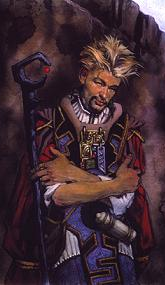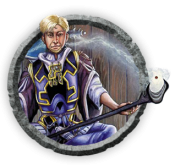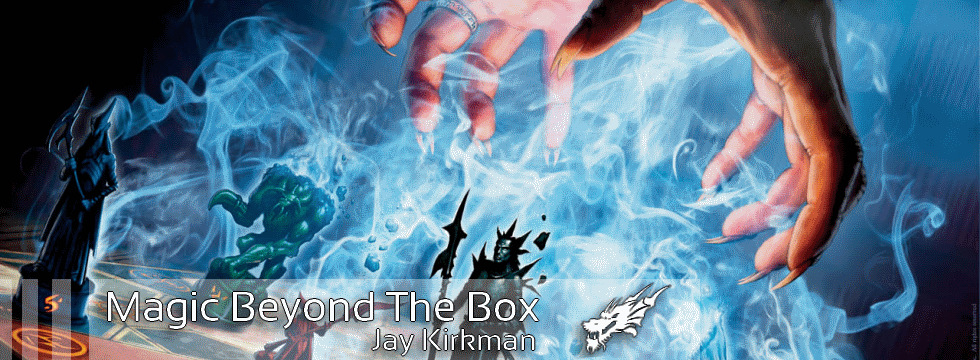Are you a Quiet Speculation member?
If not, now is a perfect time to join up! Our powerful tools, breaking-news analysis, and exclusive Discord channel will make sure you stay up to date and ahead of the curve.
 The final axe has fallen on the Great Designer Search 2, and as you likely know by now Devon Rule was given a laudatory seeing-off. Devon had made a game effort, but in the end hadn't sold the judges on his world and vision, and that was that. Next month, the remaining three will be flown to Wizards of the Coast in Renton where they'll be subjected to 'The Gauntlet,' a grueling interviews and mock design sessions to see which of them rise to the top. Hopeful recollections of multiple job offers (as was the case in the original GDS) have been explicitly squashed, so in all likelihood only one dream will find its fulfillment there.
The final axe has fallen on the Great Designer Search 2, and as you likely know by now Devon Rule was given a laudatory seeing-off. Devon had made a game effort, but in the end hadn't sold the judges on his world and vision, and that was that. Next month, the remaining three will be flown to Wizards of the Coast in Renton where they'll be subjected to 'The Gauntlet,' a grueling interviews and mock design sessions to see which of them rise to the top. Hopeful recollections of multiple job offers (as was the case in the original GDS) have been explicitly squashed, so in all likelihood only one dream will find its fulfillment there.
As I've mentioned before, I hadn't really paid attention to the GDS2 after abandoning early ambitions to 'give it a shot' when my newborn son arrived, figuring I could wait until the dust had settled and read it all in one fell swoop. This changed when the aspiring designers were challenged to build an intro pack and enlisted our help and expertise in playtesting and fine-tuning their decks. (You can read the account of Ethan's, Scott's, Devon's, and Shawn's decks here on Quiet Speculation.) The experience put me right into the thick of the competition, and so I was as breathless as any when the final results of this last challenge went up on the mothership.
It made for riveting reading. Not only did I now have an emotional stake in the outcome, having lived their decks for an entire weekend plus, but on a more general level the chance to look behind the curtain at some of the inner workings of intro decks was compelling stuff. Especially intriguing was the ability to look at feedback and judgments I had made on the decks and their component cards, and see how they lined up with the august four-person panel of Mark Rosewater, Tom LaPille, Ken Nagle, and Graeme Hopkins. As it turned out, the results were quite surprising. One reminder before we plunge in: the decks that we tested weren't always the same as the ones submitted for judging. I'll try and note the differences when discussing a specific card.
 Ethan Fleischer, Tooth and Claw
Ethan Fleischer, Tooth and Claw
I had a policy in place at the time that prevented me from "playing favourites" with regards to what I thought about the decks and their potential prospects which can now be safely discarded with the final judgment having officially been rendered. A bit silly, perhaps, but I felt it best if I adopt a neutral stance as I was reviewing the work of all four finalists. Tooth and Claw was our overall pick for 'best in show.' In our extensive gauntest of tests, it felt like the deck with the most overall polish and the evolve mechanic was a blast.
What We Thought: We were initially concerned with its power level. It amassed an impressive 12-6 record on the first round of testing, leading us to mention to Ethan that its record "is a bit of a concern as well, but I'll want to see how it does against a couple Rise of Eldrazi and Scars of Mirrodin decks before drawing too many conclusions." On the second day of testing it went a more balanced 4-5, giving us some reassurance.
What the Judges Thought: Ken Nagle put it bluntly. "This deck was overpowered in the playtest." In addition to power level and the lack of 'obviously bad' cards, another concern of the judges was the excessive use of the evolve mechanic. Said Rosewater, "I believe you have too many evolve cards. It's good for the deck to have focus, but you don't want evolve to take over to the extent that it feels like it's all the deck does."
Reaction: My first thought brought to mind Zendikar's The Adventurers, which had 80% of its creatures as Allies, but the more I thought about it the less apt the comparison seemed. Unlike Allies, who more or less suffer unless surrounded by other Allies, evolve creatures could function just fine with even just a splash of them in a deck. In that regard, I did have to allow that Tooth and Claw might have been a bit more theme deck than intro pack. Pairing up our deck report with the judges' statements, we were fairly close to the mark here.
I thought Migration Route, a land fetch that pulled a land from your deck to your hand and gave you the option of a second to the top of your library if you wished was elegant and fun. It was changed before submission to bring the first to play instead, but was not a hit with the judges. Said Rosewater, "I often found myself annoyed that I lost my next draw. On two occasions, I needed the second color but had plenty of mana in my hand making the bonus land a drawback." That didn't make much sense, since the "bonus land" was optional and shouldn't be seen as a drawback.
We were in agreement that the 1-drop evolver Eohippus was "very strong" and a very welcome presence in your opening hand, while Fecund Maiasaur (spits out 2/2 dino-babies with each evolve trigger) was too good in its slot. We both evoked the Turntimber Ranger by comparison.
Overall, great deck, and not at all surprising that it advanced.
![]() Scott Van Essen, Breakout from Malgareth
Scott Van Essen, Breakout from Malgareth
This deck was our next-favourite, though reaction amongst the playtesting group was a little more split. As the most spike-ish of the three, I really enjoyed the options and decisions that the breakout mechanic forced, where if one of your attacking creatures got through unblocked all your breakout cards triggered added bonuses. Reviews otherwise were a little more mixed.
What We Thought: "It feels like there’s nothing in the deck that’s not doing some busywork," I wrote to Scott, "and that starts to feel more like Constructed and less like an intro deck." I recommended adding in some vanilla creatures, as this would have the additional benefit of keeping the creatures a little more on-curve and reduce the deck's chances of falling behind. The breakout ability carried a premium in the casting cost of a creature, and many of them had smallish bodies. We noted that breakout was a little difficult to grok at first for a new player, but once seen in action could be readily grasped.
What the Judges Thought: Rosewater hit upon this as well. "There is a subclass of spells that read poorly but play well," he explained. "Exalted from Shards of Alara falls into this subset. Usually it involves some condition that seems hard to do but once you start playing with the cards you realize that it's a lot easier than you thought at first blush."
Not being a huge fan of creature combat, I really enjoyed the novel dimension that breakout added to it. Rosewater hit the nail on the head here when he remarked, "I love mechanics that make you have to rethink what's important so long as it's not too mentally draining to do so. Breakout seemed to hit the sweet spot."
Although over the course of the articles I would come to really enjoy Tom LaPille's insights, I did not agree with his dismissal of breakout. "The theme of this deck is so deafening to me," he said. "It feels more like a theme deck than an Intro Pack deck." It's a fine line to draw: the line between LaPille's theme and intro decks is a fine one in a world of The Adventurers and Scars of Mirrodin's Metalcraft, the latter of which boasts over half its nonland components with its namesake keyword.
Although thus far our reviews and the remarks of the judges were typically within the same ballpark, things were to go in quite a different direction here. We had Devon's deck in last place, which should come as little surprise given that we abandoned testing after three rounds and resubmitted it to the designer for an overhaul. Of all the designers, Devon seemed to put the least stock in our outcomes, claiming that his playtesting showed different results and ending our correspondence without so much as a thank you for our effort.
What We Thought: In a word? Broken. From top to bottom we felt that Devon had some interesting ideas at play here, but the mechanics of the deck were unsustainable. When I was able to engineer a 17/17 crusher with intimidate on turn 5, the deck seemed to have far more in common with a constructed deck than an intro pack. "In short," I summarised, "the ability of mana to be hoarded in the early game has the consequence of being massively swingy, because you can reap a ton of Gold Counters early and make some truly sick plays. Second, swingy outcomes are hard to predict and, therefore, hard to plan for. You might tone the deck down some to diminish the risk of such upper-end results, but then is there enough in the deck to hold steady when you don’t get any such accelerants at all?"
What the Judges Thought: Although the Rental Hydra (the 17/17 body) remained in the deck intact, one of the most egregious offenders was given a well-deserved nerf. The Lotus Vendor was initially a Llanowar Elves that tapped for gold counters, but this was changed in the finished product to act as something of a filter/battery instead. What allowed the Hydra to become so bloated was the hireling mechanic, which bestowed +1/+1 counters to a keyworded creature for each gold counter cashed in to help pay for its casting. This meant that most hirelings had an upper 'growth limit' set by their casting cost, and the numbers could be tweaked to ensure balance. The Hydra was simply a single Green mana and X. "Having a single unbound hireling seems like a good idea," noted Graeme Hopkins.
Even with Devon's fixes, I wasn't convinced. "Certain cards," observed Rosewater, "get you gold too easily." I just didn't feel that the right balance was struck here. With City of Gold, the judges and I parted ways.
Blight was a rather tricky mechanic that had the whiff of being brokenly overpowered, but actually was quite reasonable in its execution. In short, 'blighting' a permanent marked it for destruction, but its doom was only foretold. Only when another blight effect was triggered would all such marked permanents be destroyed, only to begin the process anew.
What We Thought: I really enjoyed the rather elegant design space being expolored by the blight, in particular where the blight either had limited targetability (for example, a Naturalize variant that blighted only artifacts or enchantments) or had other applications (like the Blightsky Elemental, who decreed that all creatures with blight counters on them would lose the flying keyword). On the other hand, my playtest partners were not so keen, as one noted when she said that having to continuously set up intricate series of plays made her feel like she "had to go fishing to cause [her opponent] pain."
What the Judges Thought: They were with my partners on this one. Tom LaPille summed it up best when he said, "Let's talk about blight for a little bit. Overall, I found it rather miserable to play with. I had this enormous pile of cards that read and played to me like "Do half of what you want to do." I don't want to blight things, I want to kill them. Especially frustrating were spells that blighted things, when I am used to playing with spells that outright kill things. The blight cards collected together, rather than alleviate this problem, made me feel like I was fighting someone while knee-deep in molasses.... It made me wish I just had a Doom Blade."
They had a point. The lack of precision removal was often frustrating. "It’s undoubtedly a tough balance," I Noted in my report to Shawn, "you don’t want to sprinkle in a bunch of [card Doom Blade]Doom Blades[/card], because that makes it too good at removal when paired with Blight. But fundamentally a player does want to feel in control of their deck, and Blight doesn’t give them the same reassurance."
Nagle's conclusion was about right. "Blight many things, don't touch the blighted thing and hope to draw another blight card. While I have qualms about the Wodotha set design having enough "meat" to sink my teeth into, it's more than enough for this Intro Deck exercise. Once again, good job using what you were given."
About Those Intro Packs
Perhaps the most enjoyable part of the read was the collective insight on the construction of intro decks, and much of this came from Tom LaPille. Sprinkled thoughout the varies deck reviews were little nuggets of wisdom regarding their aims and means. The most basic of these was the need for vanilla creatures, a point Tom made more than once. As it turns out, he has a number in mind- three- but the guidelines on construction go deeper than that. Here are some of the highlights.
Sometimes, bad cards are good. "Part of why I like [Fog] is that it's actually not very good," said Tom. "One of the stealth lessons we try to put into Intro Packs is that sometimes a card isn't actually worth playing in a deck. You're not trying to stall for anything in particular, so Fog isn't worth much to you. Eventually, someone might figure that out, cut the Fog for something else, and be on their way toward a happy lifetime of designing decks."
Ken Nagle took this point even further. "One thing I'd like to see is an obvious bad card that even a new player will dislike. When I say bad, I mean really bad. The card's badness should be nausea-inducing to an experienced player like you and me. New players are very forgiving to new cards. You have to scream badness at that volume for new players to hear it.
Why go to such lengths to first make disgustingly bad cards, then include one in a fixed deck product?
If you do it just right, a new player will take out a card and put in a card they like better from their booster pack. This is the behavior we want to teach players who purchase Intro Packs. Every day, new players take this first step in learning Magic deck-building."
This was a refreshing point to hear echoed by design and development, as this was something I had myself hypothesized about intro decks not long ago.
Core Set cards serve a purpose. This was especially illuminating to me, as I have tended to consider the inclusion of Core Set cards as a black mark against an intro deck. In small amounts they're inobtrusive, but I have very quickly taken exception to the erosion of a deck's flavour when there's too many "generic" inclusions. So I was rather surprised to learn the purpose they often serve when Tom LaPille remarked about one of Ethan's dinosaurs, "note that you won't get reminder text on this guy's trample ability because he is not in a core set. Whenever possible, I try to include a core set card with a mechanic that I'm including so that mechanic is explained on the new player's cards somewhere."
Aha! So that explains why Child of Night and Vampire Nighthawk are such frequent fellow-travelers.
These are but the barest excerpts here. I urge anyone who has an interest not only in intro pack design, but in card design overall to check out the Great Designer Search 2 if they have not already. I began as a playtester for all four decks, and ended up learning quite a bit more than I thought I might. Quite fortunate indeed!
The Contest
And speaking of fortune, what better way to end than with the announcement of our two winners from last week's contest. Readers had the opportunity to win a foil Elspeth Tirel by letting us know what their favorite preconstructed deck is and by retweeting the contest announcement. In a similar vein, by exploring additional Timmy content on the site one lucky reader would snare a foil Fauna Shaman.
We're thrilled to note that the participation was fantastic, and the lucky winners are...
Elspeth Tirel: Ethan Fleischer
Fauna Shaman: Stric9
If you're a winner, please be on the lookout for an email shortly so we can send out your prize. That's all for now, thanks for reading!
_____
Jay Kirkman
@ErtaisLament on Twitter
ErtaisLament.com







The "core set cards have a purpose" was particularly illuminating to me as well. I hadn't seen a pattern in what cards were included from core sets until Tom LaPille pointed it out.
And thanks for the Elspeth!
Woo-hoo! A great card for one of my green decks!
Wah! No Elspeth for me! haha, nice article… I am actually working on a set right now and would like to make intro packs eventually. Would that be something you guys would take a look at (just for critique in both my intro deck making and design skills) or would that not fly?
Hey Jon- sorry for the delay in getting back to you… hectic week! But we'd be delighted to assist, we're working on one custom set right now with another on-deck. Once you're ready to enter the intro pack phase with a relatively complete card pool, shoot us a line at ertaislament (at) gmail.com and we'll get underway!
Congrats to the winners.
I like that the judges were worried that there were too many creatures with theme abilities (evolve and breakout) in their respective intro packs, meanwhile Path of Blight, for example, has no creatures without infect in it. Seems a bit odd to me…